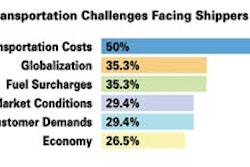The ultimate success of any supply chain depends on the ability of trading partners to set and meet expectations. Ask a company how well it is doing this, and most will tell you that they are successful in their implementations. Ask a company’s customers how well they are doing this, and most will say that there are still major challenges to a smooth integration. Why the discrepancy?
The discrepancy arises from companies not fully implementing supply chain visualization and taking advantage of all the benefits it can provide. The lack of full implementation happens for two reasons: First, companies need access to trading partner data to achieve visibility, but often they are trading only 65 percent or less of their supply chain volume electronically. The second reason is that when it comes to electronic collaboration between supply chain partners, the 80/20 rule generally applies — companies are collaborating electronically with the 20 percent of suppliers who represent 80 percent of their supply chain volume. Their smaller customers are still using phone, fax and e-mail to collaborate, leading the majority of customers to believe that companies are not effectively using supply chain visibility to meet deadlines.
With supply chain visibility solutions, companies have greater access to customer order information, allowing them to more easily check the status of orders, and customer service personnel can view the full lifecycle of a purchase order (PO), allowing them to more quickly resolve customer disputes. Inbound orders benefit, too, because procurement and supply chain management can maintain order visibility once a PO is placed with suppliers, and action can be taken quickly if orders are going to be delayed.
By contrast, failure to achieve this level of visibility can have serious consequences, such as decreased profits due to excess and obsolete inventory, decreased customer satisfaction due to poor on-time delivery, and eroded market share due to competitors’ product innovation and better time to market.
To fulfill the promise of supply chain visibility, a company must have real access to trading partner data, and here is where the problem lies. Companies continue to struggle to connect electronically — i.e., sharing signals and automating business transactions and processes in a bidirectional manner — with the majority of their trading partners. This is often the result of having fewer and fewer IT resources to deal with the range of partner capabilities and the disparities in data formats, protocols and standards between external business systems. Furthermore, fierce competition and eroding margins continuously exert internal pressure to reduce costs, which leads to IT initiatives that fail to improve multi-enterprise collaboration.
The complexities and challenges of modern supply chains fuel the need for greater process integration across all trading partners, regardless of size, for planning, production, inventory, purchase-to-pay and shipment information. The ability to exchange more and richer information results in more accurate planning and better mid-course corrections to improve order-to-cash cycles. Companies also are better able to improve customer service and enhance revenue.
On-demand Networks Offer Flexibility to Improve Partner Collaboration
While traditional value-added network services have facilitated electronic data interchange (EDI) collaboration between large companies and their core partners, integrating smaller manual suppliers into these networks has often been a challenge. This challenge is most often due to a lack of technological expertise by the smaller partner or a perception that the cost outweighs the benefit.
This situation is fortunately changing as new business services make it easier to on-board small partners. On-demand networks can now send a range of business documents — purchase orders, acknowledgements, advanced ship notices, invoices and payment remittances — in EDI, XML or flat-file format with significant benefits. In fact, some companies have realized a reduction in manual processing errors by up to 90 percent within their order-to-cash process as a result of automation.
New network fax conversion services can translate faxes into electronic transactions and transmit them into back-end systems. These conversion services allow midsize and larger companies to automate faxes from partners that are not sophisticated enough or do not possess the necessary IT resources to trade electronically. One very large bank now is able to on-board its small-to-medium business customers in less than 30 days and electronically transact with these businesses that previously only sent and received faxes.
Additionally, new Web portals provide companies and their trading partners, regardless of their size or technical expertise, with a secure site to create and exchange business documents over the Internet. These portals eliminate the need for faxes, phone calls and paper documents, which are difficult to manage, can introduce errors and delays, drive up administrative costs and impair the performance of efficient business processes or supply chain operations.
Supply Chain Visibility On-demand Furthers the Competitive Advantage
Even more promising is the emerging trend of offering business applications on demand. Applications, such as supply chain visibility, that depend on communities of users for success are the best fit for on-demand delivery. Hosted by the vendor and paid for on a subscription basis, on-demand solutions provide a number of benefits over on-premise or custom/homegrown solutions. To begin with, they provide access to all network partners regardless of connectivity preference, as well as business process integration across multiple enterprise resource planning (ERP) or planning systems.
On-demand supply chain visibility solutions also facilitate another key issue challenging companies: continuous process improvement in order to meet changing supply chain requirements. The investment in existing software applications forces companies to constantly evolve or upgrade their solutions to keep up with these changes. On-demand solutions enable faster implementation time and automated software upgrades. That, coupled with reduced total ownership cost and upfront cost, yields a faster return on investment.
Whether on-demand supply visibility solutions support customer order-to-cash (outbound) or supplier procure-to-pay (inbound) visibility, they are most effective when they feature a dashboard that provides a clear and concise view of customer and supplier information. A dynamic view of performance improves product availability, reduces inventory and aids revenue growth.
The Aberdeen Group reports that companies across industries gain a competitive advantage when they implement on-demand supply chain visibility solutions because they generally are almost two-and-a-half times as likely to have lowered inventory, two times as likely to have faster order-to-delivery times and two times as likely to have an on-time delivery rate of 95 percent or higher.
At last, companies can realize the promise of supply chain visibility. By coupling on-demand network services that enable small partner collaboration with new supply chain visibility applications that accommodate process changes, supply chains can respond to dynamic market conditions and event disruptions. With the obstacles to operational efficiency and responsiveness gone, so, too, is the uncertainly about delivering on a promise.
About the Author: As Vice President, Products & Marketing for Sterling Collaboration Network, Philip Smith is responsible for managing the global P & L for Sterling Commerce's network, managed services and data sync services businesses. He also is responsible for setting strategy, defining and bringing to market all of Sterling Commerce service-based solutions. Smith has more than 22 years experience in IT services and data/voice communications in both the commercial and consumer sectors. Most recently, he was vice president of solutions marketing for outsourcing services at Unisys Corporation. Prior to joining Unisys, Smith was vice president of marketing and sales at CoreComm Ltd., a provider of competitive local exchange services. He also served as director of product management for UUNET, a leading Internet communications provider. Earlier in his career, Smith held a series of marketing and management positions at CompuServe. He earned Bachelor of Science in information systems management from Bowling Green State University, Ohio, and an MBA from Xavier University, Ohio. www.sterlingcommerce.com.



















